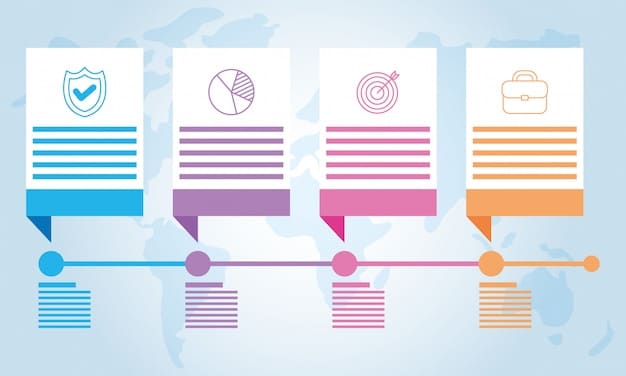US Tech Export Restrictions: What to Know Before December 2024

New US export restrictions on technology are set to take effect in December 2024, impacting various sectors; understanding these changes is crucial for businesses involved in tech exports to ensure compliance and avoid potential penalties.
The landscape of US technology exports is undergoing significant changes, and understanding the upcoming regulations is paramount for any business involved. The Alert: New US Export Restrictions on Technology – What You Need to Know Before December 2024 will impact how companies operate, innovate, and compete globally. Ignoring these shifts could lead to severe consequences; thus, preparation is key.
Understanding the Impending US Export Restrictions
As we approach December 2024, it’s crucial to understand the impending changes to US export restrictions on technology. These regulations aren’t just bureaucratic hurdles; they represent a paradigm shift in how the US government intends to control the spread of sensitive technologies. This section will break down the key aspects of these restrictions and why they matter to your business.
These restrictions are designed to protect US national security and maintain its technological edge. They target technologies deemed critical for military or strategic advantage, aiming to prevent them from falling into the hands of potential adversaries.
What Technologies Are Affected?
The new regulations cover a wide range of technologies, not just those directly related to defense. This includes areas like artificial intelligence, advanced computing, semiconductor manufacturing equipment, and telecommunications technologies.
- Artificial Intelligence (AI): Restrictions apply to AI algorithms used in facial recognition, autonomous systems, and data analytics.
- Advanced Computing: High-performance computing systems and related software are under increased scrutiny.
- Semiconductor Manufacturing Equipment: Equipment used to produce advanced semiconductors faces tighter export controls.
- Telecommunications Technologies: 5G and other advanced telecommunications equipment are subject to export restrictions.
Understanding which specific technologies are affected is the first step in ensuring compliance. Companies must identify if their products or services fall under these categories.
In conclusion, the forthcoming export restrictions represent a significant shift that demands the attention and proactive measures from all stakeholders operating in the technology sector. Ignoring these changes can have far-reaching implications.
The Rationale Behind the New Export Controls
The introduction of new export controls is rooted in a complex interplay of national security concerns, economic competitiveness, and geopolitical strategy. To effectively navigate these changes, it’s essential to understand the underlying motivations and objectives driving these restrictions.
The US government aims to safeguard its technological advantage and prevent the proliferation of sensitive technologies that could be used against its interests.

National Security Imperatives
At the heart of the export controls is the desire to protect national security. By restricting the export of advanced technologies, the US hopes to prevent potential adversaries from acquiring capabilities that could threaten its military or strategic interests.
These controls are a critical tool in preventing the misuse of cutting-edge technologies that could be detrimental to global stability.
Maintaining Economic Competitiveness
Beyond security, these controls are also aimed at maintaining US economic competitiveness. By limiting the export of certain technologies, the US aims to retain its leadership in key sectors like AI, computing, and semiconductors.
- Protecting Intellectual Property: Export controls help prevent the theft or unauthorized transfer of valuable intellectual property.
- Supporting Domestic Industries: By limiting foreign access to critical technologies, the US can support the growth and innovation of domestic industries.
- Ensuring Fair Competition: Export controls promote fair competition by preventing the unfair acquisition of US technology by foreign entities.
These controls are not just about restricting exports; they are also about fostering a healthy and competitive domestic technology ecosystem.
In essence, the new export controls are a reflection of the evolving global landscape. As technology becomes increasingly central to national security and economic prosperity, governments are taking steps to protect their interests.
Key Changes to Export Administration Regulations (EAR)
The Export Administration Regulations (EAR) are the primary set of rules governing US export controls. Understanding the key changes to these regulations is essential for businesses seeking to comply with the new restrictions. These changes will dictate how companies can legally export their products and services.
The EAR is constantly evolving to keep pace with technological advancements and emerging security threats.
Expansion of the Entity List
The Entity List is a roster of foreign individuals, companies, and organizations that are subject to specific export restrictions. The new regulations expand this list, adding more entities that are deemed to pose a risk to US national security or foreign policy interests.
Being placed on the Entity List can have severe consequences, effectively barring companies from doing business with US entities.
Tightened Controls on Emerging Technologies
The new regulations impose stricter controls on the export of emerging technologies, including AI, quantum computing, and biotechnology. These technologies are considered critical for maintaining US technological leadership.
- Licensing Requirements: Companies exporting these technologies may need to obtain special licenses from the US government.
- Enhanced Review Process: Export license applications will be subject to a more rigorous review process.
- Restrictions on End-Use: Restrictions may be placed on the end-use of exported technologies to prevent their misuse.
Companies operating in these sectors must be prepared to navigate the complexities of the new licensing requirements and enhanced review process.
In summation, the changes to the EAR reflect the US government’s growing concern about the potential misuse of advanced technologies. It is imperative that companies stay abreast of these developments.

Impact on US Businesses: Compliance Challenges
The new export restrictions pose significant compliance challenges for US businesses, particularly those involved in the export of advanced technologies. This section will explore the various hurdles that companies face and provide guidance on how to overcome them. Overcoming these challenges is crucial for maintaining competitiveness and avoiding penalties.
Compliance with export control regulations is not a mere formality; it is an integral part of responsible business practice.
Classification and Screening
One of the first challenges businesses face is accurately classifying their products and services under the EAR. This involves determining the Export Control Classification Number (ECCN) for each item, which determines its export control status.
Accurate classification is essential for determining whether an export license is required.
Licensing Requirements and Exceptions
Many exports of controlled technologies require a license from the US government. Obtaining a license can be a complex and time-consuming process. Companies must navigate the complex web of regulations and demonstrate that their exports will not harm US national security or foreign policy interests.
Understanding the licensing requirements and available exceptions is crucial for minimizing delays and ensuring compliance.
In conclusion, the new export restrictions present a complex set of compliance challenges for US businesses. By taking a proactive approach and investing in robust compliance programs, companies can navigate these challenges and ensure that they remain competitive in the global marketplace.
Steps to Ensure Compliance Before December 2024
With the rapidly approaching deadline of December 2024, taking immediate action to ensure compliance with the new US export restrictions is of paramount importance. Companies need to implement a comprehensive compliance program that addresses all aspects of export control regulations. This section will provide a roadmap for businesses to navigate these changes and stay compliant.
A well-structured compliance program is a crucial safeguard against costly penalties and reputational damage.
Conduct a Risk Assessment
The first step in ensuring compliance is to conduct a thorough risk assessment. This involves identifying the potential risks associated with your company’s exports, including the specific technologies being exported, the countries they are being exported to, and the end-users who will be receiving them.
The assessment should identify areas where your company may be vulnerable to export control violations.
Implement a Compliance Program
Based on the results of your risk assessment, you should implement a comprehensive compliance program. This program should include policies and procedures for classifying products, screening customers, obtaining licenses, and maintaining records.
- Develop Written Policies: Document your company’s export control policies and procedures.
- Provide Training: Train your employees on export control regulations and your company’s compliance program.
- Conduct Internal Audits: Regularly audit your compliance program to ensure that it is effective.
A robust compliance program is essential for demonstrating your commitment to complying with export control regulations.
In summary, compliance with export control regulations requires a proactive and systematic approach. By following the steps outlined above, businesses can mitigate their risks and ensure that they are prepared for the new restrictions taking effect December 2024.
Expert Opinions and Industry Insights
To gain a deeper understanding of the implications of the new US export restrictions, it is valuable to consider insights from industry experts and thought leaders. Their perspectives can provide a more nuanced understanding of the challenges and opportunities that lie ahead.
Expert opinions can help businesses make informed decisions and navigate the complex landscape of export control regulations.
Perspectives from Legal Experts
Legal experts specializing in export control regulations emphasize the importance of seeking professional guidance to ensure compliance. They highlight the complexities of the EAR and the potential consequences of non-compliance.
Legal counsel can provide clarity on the regulations and help companies develop effective compliance strategies.
Views from Technology Industry Leaders
Technology industry leaders express concerns about the potential impact of the new restrictions on innovation and competitiveness. They argue that overly strict controls could stifle research and development and drive businesses to relocate to countries with more favorable regulatory environments.
Industry leaders advocate for a balanced approach that protects national security while fostering innovation and economic growth.
In conclusion, the perspectives of experts and industry leaders offer valuable insights into the multifaceted implications of the new US export restrictions. By considering these viewpoints, businesses can develop more comprehensive and effective compliance strategies.
| Key Area | Brief Description |
|---|---|
| 🚨 Upcoming US Restrictions | New regulations on tech exports effective December 2024. |
| 🎯 Impacted Technologies | AI, advanced computing, semiconductors, and telecommunications. |
| 🛡️ Ensuring Compliance | Perform risk assessments and implement robust compliance programs. |
| 💼 Business Adaptation | Companies must adapt strategies to align with evolving global landscape. |
FAQ Section
▼
The primary aims are to safeguard US national security, protect technological advantages, and prevent sensitive technologies from reaching potential adversaries. This regulation is pivotal for maintaining global stability.
▼
Key sectors include artificial intelligence, advanced computing, semiconductor manufacturing equipment, and telecommunications. These industries require careful compliance adherence to navigate regulatory landscapes effectively.
▼
Companies should conduct risk assessments, implement comprehensive compliance programs, train employees, and seek expert legal advice. This helps minimize the chances of facing penalties and disruptions.
▼
The expansion means more foreign entities are subject to export restrictions, potentially barring US companies from conducting business with them. Scrutinizing and monitoring this list is paramount to ongoing compliance.
▼
Non-compliance can lead to severe penalties, including fines, denial of export privileges, and even criminal charges. Proactive measures thus protect both businesses and their executives from substantial risks.
Conclusion
In conclusion, the new US export restrictions on technology represent a significant shift in the regulatory landscape. Businesses must take proactive steps to understand these changes and ensure compliance before December 2024. By embracing a culture of compliance and seeking expert guidance, companies can navigate these challenges and remain competitive in the global marketplace.





